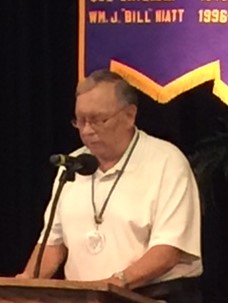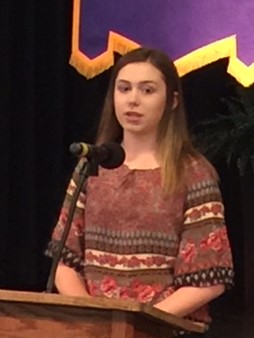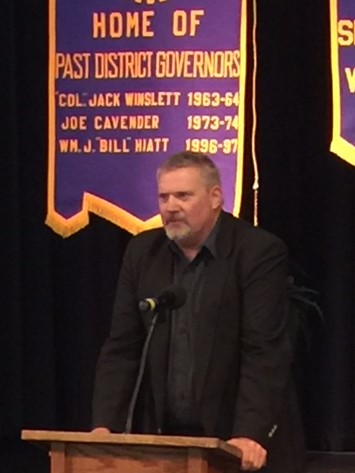Scholarship Recipients and Hanford - Ben Harp
North Notes
Spokane North Rotary Club Bulletin
June 19, 2017
Bravo!!
Thanks mainly to the efforts of fund raiser coordinator Robbie Jackson, an astonishing total of $20,262 was netted for needy students and an array of projects for Holmes Elementary School and some other schools like Glover Middle School and North Central High School.
Total revenues were $23,637 and expenses were $3,375, Jackson said. Some 89 people attended The Backyard restaurant, as auctioneer Bill Simer smoothly worded through the events: silent and live auctions, “Heads and Tails” game and the “Call for the Cause” donations.
Corporate sponsors donated $7,350 and five live auction items included $5,475. Jackson distributed itemized details to club members. Congratulations to all who worked so hard.
Briefly:
Rotary ending: The last event of the Rotary calendar year is the installation program and banquet, 6 p.m., at Monday, June 26 at the Kalispel Country Club. No luncheon meetings are planned June 26 and July 3, on the holiday eve.
Congratulations to club President Nancy Hanson for an outstanding year and best of luck to Chad Haverkamp as he begins his 2017-18 Rotary year.
 Saling scholars honored
Saling scholars honoredChuck Rehberg shared that the following graduates from North Central, Shadle Parkand John Rogers high schools were selected as the club’s Gerald L. Saling scholarships. Each student received $1,500:

Emma Vandine, of North Central, plans to attend Biola University in LaMirada, Calif., majoring in marketing and Biblical Studies.

Andreya Fletcher, of Rogers, plans to attend Eastern Washington University, majoring in environmental studies and business.
Vandine and Fletcher attended the June 19 luncheon, while Kuhn was out of town and will visit the club later.
Lenore Romney coordinated the scholarship program, joining committee members Art Rudd, Brian Hipperson, Melinda Keberle and Chuck Rehberg.
At Hanford, timelines are long and costs are high
Ben Harp shows an encyclopedic mind about all things Hanford, as he details the awesome, complicated issues of radioactive wastes in south-central Washington.
 Harp is deputy manager for the U.S. Department of Energy’s Office of River Protection. At the June 19 meeting, Harp talked in detail about safe storage, retrieval, treatment and disposal of 56 million gallons of chemical and radioactive wastes at the Hanford Site.
Harp is deputy manager for the U.S. Department of Energy’s Office of River Protection. At the June 19 meeting, Harp talked in detail about safe storage, retrieval, treatment and disposal of 56 million gallons of chemical and radioactive wastes at the Hanford Site. Ben, who first joined Energy in July 1991, said got his degree in engineering, but spends as much time consumed by the legal tangle of various jurisdictions and the mountains of scientific issues involving Hanford.
This bulletin space is not the place to get into all the details; suffice to say, Harp presented a first-rate knowledge of the 70-year-plus history of plutonium at Hanford.
Six of the original none reactors have been “cleaned up,” he said, adding,“ one is a museum and two more to go.” Some 60 leaky single-walled tank sites have been transferred to double-walled tanks.
But it will take at least until age 2022 to “vitrify,” or immobilized in glass, much of the wastes. Harp said just one of many issues is the competing of techniques – “grout vs. glass.” At the eastern U.S. reactors at the Savannah River plant,
wastes were put in grout, but Hanford leaders prefer vitrification.
Bad news surface occasionally, like the May 9 tunnel collapse in fuel rods, in which, by order “all people had to take cover.” Harp said though the issues were minor, people, including a Mead School class where he talked, “the students were frightened.” He said Sens. Patty Murray and Maria Cantwell, D-Wash., shared their own concerns. Scary very hot issues, like cesium and strontium, dangerous elements “that grow in the dark,” tend to bring that reactions.
Calming assurances that the pump-and treat tank wastes have not reached the Columbia River and that “some Spokane basements than more than certain Hanford sites,” nevertheless get wary questions.
For those who want to dive into the mountain of Hanford details, a half-dozen websites await.
For a more casual look, Harp has sheets of slides to share, and many stories about significant clean-up to date. (He said it’s like looking at a 10-year old who doesn’t seem to grow much each day; but when looked several years ago, seems to grow quite a bit.) Hanford covers 486 square miles of challenges, but at least 1,441 acres have been transferred for redevelopment for tribes and others, Harp said.
Still, the answers at Hanford are still decades away and the accumulated costs continue to build in trillions.
Closing the meeting, President Nancy Hanson said: “And I think I had problems.”
The bulletin producers:
Bulletin editors: Chuck Rehberg and Sandy Fink
Photo: Eric Johnson
Program coordinator: Brad Stark
